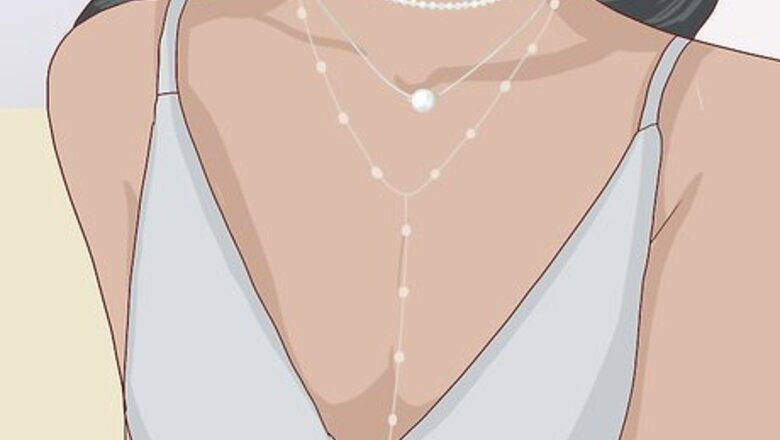
views
Picking the Pieces

Aim for the same style. When you’re new to layering, it helps to choose jewelry that all has a similar style. You might opt for all antique or vintage pieces, or go for an edgier look with studded or spiked items. Select pieces that all have a similar aesthetic so they look like they belong together. The easiest style to start with when you’re layering jewelry is minimal pieces. Choose necklaces with small, delicate pendants, fine chain bracelets, or rings with thin bands. If you really want to make a bold statement with your layered jewelry, you can pair contrasting styles. For example, you might layer an antique ring with a studded modern style. Keep in mind, though, that it's a more dramatic, risky look so it's best for an evening out rather than a casual, everyday occasion.

Choose a common element. If you’re new to layering jewelry, you’ll have an easier time if you select pieces that all share a common element or theme in addition to a similar style. Choose pieces that are all made of the same metal or material, or go with pieces that all feature the same type of gemstone. Pieces that all have the same shape charms can also work. The easiest way to find a common theme is to stick to jewelry that’s all the same metal or material. For example, choose all gold necklaces or all silver rings. If you want to mix metals or materials, select items that all feature the same gemstones. For example, you might choose gold and silver necklaces that all have pearl details. Utilizing a similar shape can also help when you’re mixing metals. For example, you might mix gold and rose gold rings that all feature heart-shaped designs.

Mix weights. While you want to choose jewelry that has a similar style and some type of common theme for layering, you don’t necessarily want all of the pieces to look the same. To add some variety to your look, use items that have different weights, such as pairing skinny rope chains with chunkier beads. For example, you might pair a thin gold chain with a small pearl pendant with a strand of large chunky pearls.

Keep your look balanced. When layering jewelry, you want to focus the attention in one area or you may wind up with an overdone look. If you’re wearing several necklaces, opt for a single bracelet and simple ring. If you’re wearing a stack of bracelets, choose a delicate chain necklace. That will give you a more balanced look. If you’re headed out for the evening or a special occasion, you may want to make a bolder statement and layer your jewelry in more than one area, such as wearing multiple necklaces and stacked bracelets. It’s still best to keep the rest of your accessories minimal, though.
Layering Your Necklaces
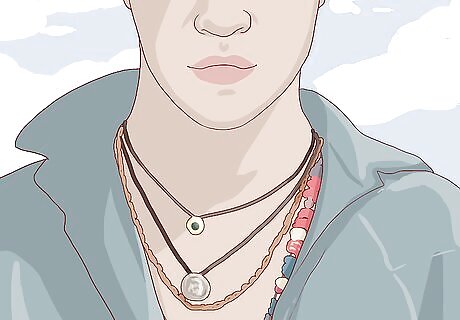
Wear necklaces in different lengths. The key to layering necklaces is choosing pieces that vary in length so you can stagger them. It’s usually best to start with a choker or 16-inch (41-cm) necklace that will fall high on your neckline and go down a couple of inches (5-cm) with each additional necklace. Not only does varying the length of your necklaces allow each to stand out, it helps prevent them from becoming tangled while you’re wearing them.

Adjust your pendants. If you are wearing necklaces that are similar in length, make them stand out from one another by playing with the placement of their pendants or central charms. For example, you might leave one in the center, slide another to rest a few inches (7.5-cm) to the right or left of center, and move another to sit on one side of your collarbone. Your necklaces may get slightly tangled if you wear them in this way. Don’t worry about it -- it can actually add to the look.
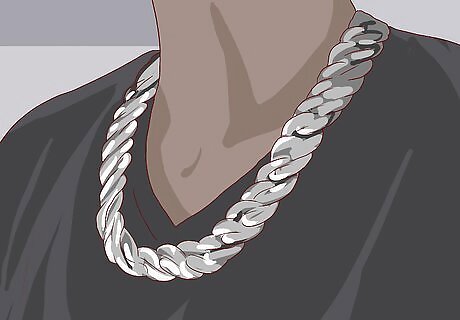
Use chunky necklaces to create a collar effect. You can create a bold look by layering several heavy, chunky statement necklaces that rest almost on top of one another. It will give you collar-like effect that helps draw attention to your face. For example, you might layer a chunky gold chain necklace, a colorful enamel necklace, and boldly shaped gold statement necklace that are all about 16- to 18-inches (41- to 46-cm) long. To keep the look from appearing too heavy, don’t use more than two or three statement necklaces to create the collar effect. This is an ideal way to layer necklaces over a collared shirt, but you can also do it with a high neck, boatneck, or scoop neck top.
Wearing Layered Bracelets
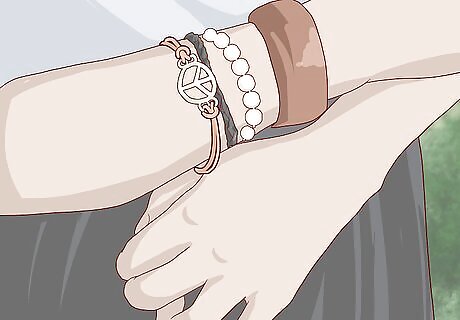
Focus on one wrist. If you’re new to layering bracelets, it’s best to keep things simple. Instead of wearing multiple bracelets on both wrists, limit your layering to one wrist. You can wear as many bracelets as you’d like on that wrist if you leave your other one bare. If you don’t want to leave your other wrist completely bare, stick to one simple, delicate bracelet. That will keep you from looking overloaded.
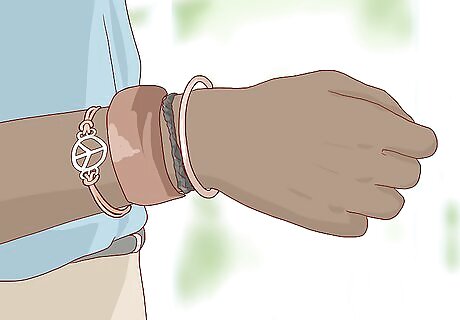
Vary the thicknesses and shapes. To make sure that your layered bracelets stand out and add to your outfit, it helps to vary the thicknesses and shapes of your bracelets. Layer some thin chain bracelets with a chunky bangle, or pair a couple of round bracelets with a square style. If you prefer wear bracelets that are similar in width and shape, you can add visual interest to the look by mixing materials, such as metal and beads, for added texture.
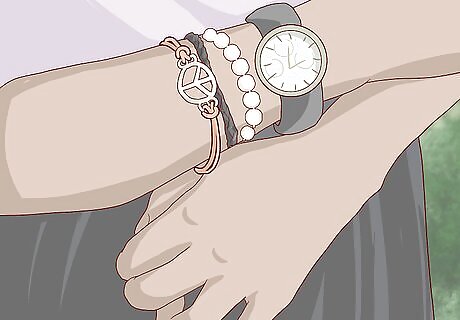
Work in a watch. When you’re layering bracelets, there’s no reason why you can’t incorporate your favorite watch. As with any type of jewelry, though, make sure that your watch shares some common element with the bracelets. For example, if you’re wearing gold and silver bracelets, choose a watch that’s gold, silver, or features elements of both. If your watch doesn’t have a metal band, try to match the color of the leather or other material to the bracelet’s details.
Styling Your Rings
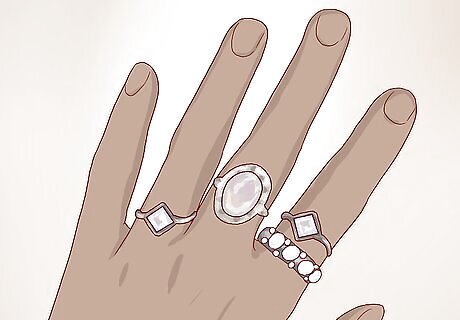
Spread the rings out across your fingers. While layering your rings means that you can wear multiple pieces on a single finger, you can maximize the impact by spreading them out across more than one finger. For example, you might wear a single ring on your index finger, three or four on your middle finger, and two on your ring finger. You can also wear rings on both hands to really make a statement. To highlight a specific stack of rings, you may want to leave the finger next to it bare. When you’re deciding how to spread out your rings, consider wearing a pinky and/or thumb ring to add even more personality to your look.
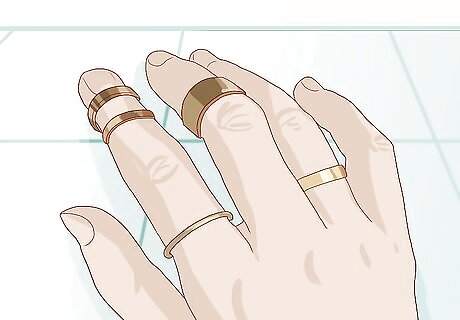
Place the rings on different sections of the finger. Your layered rings will look less styled if you adjust the placement. Instead of wearing all of them at the base of your finger, vary them. Place some rings closer to the end of your finger, some in the middle, and some at the base so your look has a more eclectic feel. You don’t want your rings to fall off or feel uncomfortable, so be sure that they fit the area of the finger where you plan to wear them.
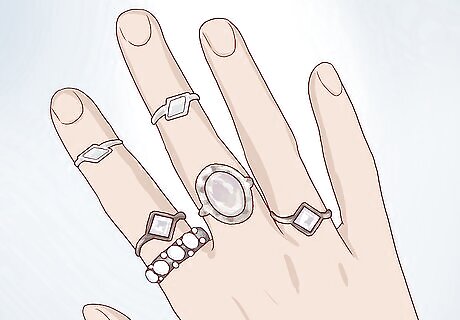
Use different sizes and shapes. Just as with bracelets, your look will have more personality if you vary the size and shape of your rings. By combining thin and chunky styles and simple round bands with designs that run vertical or horizontal, your layered rings will draw more attention. For example, you might wear a couple of thin, delicate bands on your index finger, a single oversized cocktail ring on your middle finger, and three or four styles with small stones in the center on your ring finger.



















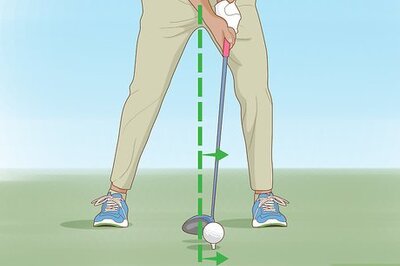
Comments
0 comment